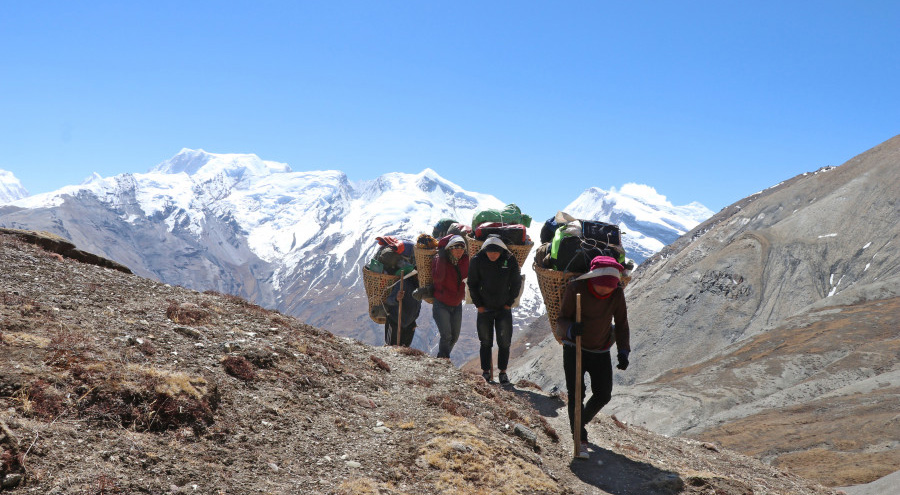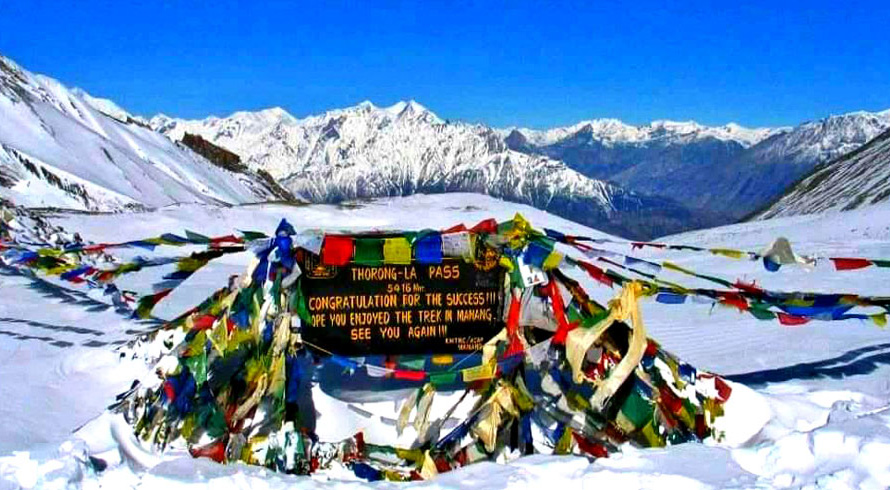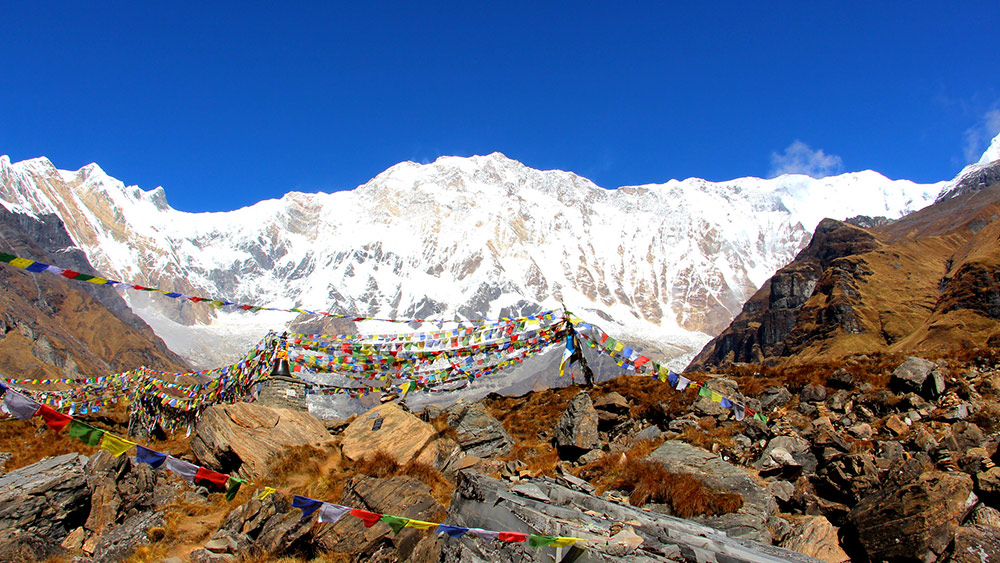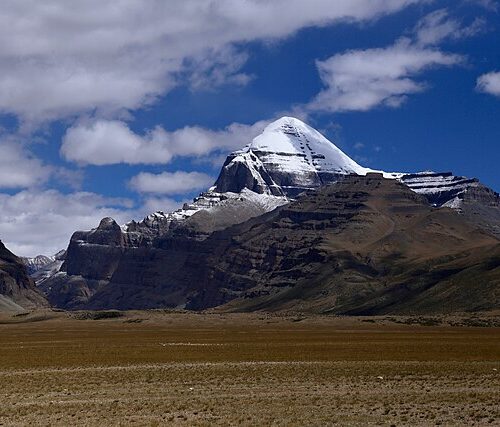Trip Facts
-
Duration
16 Days
-
Trip Start and End
Kathmandu/ Kathmandu
-
Difficulty Level
Moderate
-
Trip Area
Annapurna
-
Maximum Altitude
5416m/17,769.03ft - Thorang La Pass
-
Best Season
Spring & Autumn
-
Meals
Full Board during trek
-
Accommodation
Lodge/Tea House
-
Transportation
Flight/Jeep/Bus
Highlights
- Villages and Local Communities
- Monasteries and Temples
- Local Hospitality
- Annapurna Massif
- Machapuchare (Fishtail)
- Dhaulagiri
- High Point
- Tatopani
- Tilicho Lake
- Waterfalls
- Rhododendron Forests
- Wildlife
- Manang
- Marpha
- Panoramic Viewpoint
- Local Festivals
Trip Overview
The Annapurna Circuit with Tilicho Lake trek is one of the most renowned and diverse trekking routes in Nepal, offering a blend of natural beauty, cultural experiences, and adventure. This extended version of the classic Annapurna Circuit trek incorporates a detour to Tilicho Lake, the highest lake in the world at an altitude of 4,919 meters (16,138 feet), adding an extra element of challenge and awe to the journey. The trek begins in the lush subtropical valleys of Besisahar, where trekkers are greeted with terraced fields, verdant forests, and picturesque villages. As the trail ascends, the landscape transitions dramatically from green hills to the alpine region, revealing spectacular views of the Annapurna and Dhaulagiri mountain ranges. The route traverses through diverse climatic zones, from the temperate climate of the lower foothills to the arid and windswept terrain of the higher altitudes. Cultural immersion is a significant aspect of this trek. Along the way, trekkers encounter various ethnic communities, including Gurungs, Thakalis, and Tibetans, each with their unique traditions, languages, and lifestyles. The villages of Manang, Pisang, and Chame offer insights into the traditional Himalayan way of life, while the ancient monasteries and prayer flags scattered along the trail add a spiritual dimension to the journey.
A major highlight of this trek is the visit to Tilicho Lake, which requires a challenging side trip from the main Annapurna Circuit. The trek to Tilicho Lake is demanding, with steep ascents and high-altitude conditions, but the breathtaking sight of the turquoise lake surrounded by snow-capped peaks makes it a truly rewarding experience. The pristine beauty and serene environment of Tilicho Lake leave an indelible mark on trekkers. The culmination of the trek is the crossing of the Thorong La Pass, at 5,416 meters (17,769 feet), the highest point on the Annapurna Circuit. This pass is a challenging ascent that requires careful acclimatization and preparation. The panoramic views from the top of the pass are simply extraordinary, offering a 360-degree view of the Himalayas. The descent from the pass leads to the holy town of Muktinath, a significant pilgrimage site for both Hindus and Buddhists. The trek concludes in the Kali Gandaki Valley, passing through the ancient trade route and the bustling towns of Jomsom and Marpha, known for their apple orchards and traditional Tibetan culture. The journey from Jomsom to Pokhara provides a gentle transition back to civilization, with opportunities to relax by the tranquil Phewa Lake and reflect on the adventure.
Overall, the Annapurna Circuit with Tilicho Lake trek is a multifaceted adventure that offers a unique blend of natural splendor, cultural richness, and physical challenge. It is a trek that not only tests one's endurance but also rewards with unforgettable memories and a profound sense of accomplishment.
Detail Itinerary
+ Show More• Arrive at Tribhuvan International Airport in Kathmandu.
• Transfer to your hotel.
• Evening briefing about the trek.
- Hotel
- 1400
Cost Includes
- All land transportation and domestic flights as required for the trip itinerary
- Pick-ups and Drop-offs in a private vehicle at the airport (Arrival & Departure)
- Hotel Accommodations (Bed & Breakfast) in the city
- 3-course meal (Breakfast, Lunch, & Dinner) during the entire trek
- Accommodations in teahouses/guesthouses/lodges and tented camps as per the nature of the trek
- Necessary trek permits, national parks, and restricted areas entrance fees
- First-aid Medical Kits
- Experienced and government license holder English-speaking trekking guides
- Porters (2 trekkers: 1 porter), supporting crews, cooks, & asst. cooks (depending on the nature of the trek)
- Allowances for crew staff including insurance on medical grounds
- All government taxes, official charges
Cost Excludes
- Nepal Entry Visa Fees
- Personal Expenses
- Additional charges in the tea/guesthouses (Wi-Fi, electricity charge, hot shower, laundry, boiled water)
- Meals (Lunch & Dinner) in the city
- Extra night’s stay accommodation and meals in the city
- All kinds of Alcoholic & Non-alcoholic Beverages, Mineral Water
- Personal Trekking Gears
- Emergency Rescue cost & Travel Insurance cost
- Tips to the supporting crew members (guides, porters, drivers) after the trip completion
- Unforeseen events
Travel Info for Annapurna Region
Accommodation
Teahouses/Guesthouses/Lodges are means of accommodation in the Annapurna Region. The hotel is the accommodation in the city. Teahouses are generally simple and comfortable with basic facilities. But, trekkers must pay additional charges for the use of Wi-Fi, electronic device charges, hot water buckets, laundry, and boiled water.
Meals
Only Breakfast is provided during the hotel stay in the city. The full 3-course meal (breakfast, lunch, and dinner) is provided during the trek. The meals are basic but healthy, hygienic, and appropriate for the trekkers’ health. Fresh homegrown vegetables are served in most parts of the trek. Nepali Dal-Bhat is the main dish served with vegetable curry, and pickles which is a good source of energy for the trekkers. The meal varieties are fewer during the trek. Besides Dal-Bhat, noodles, soups, hot drinks, roti, and fresh curries are served.
Drinking water
Water drinking during the trek is very essential as it keeps the body hydrated. In the Annapurna region, drinking water is available everywhere. One can purchase a mineral water bottle or fill up the water at the teahouses. If one needs boiled water, pay an additional charge. But, remember to carry water purifying solutions/kits for safe water treatment and to stay safe & healthy. Also, carry your personal water bottle to minimize the risk of using plastic bottles and keep the environment safe.
Communication
Mobile networks and internet facilities are easily accessible in the lower regions of the Annapurna region. The network connections are fair and stable. One can pay an additional charge to use the internet facilities in the lower region. But, in the higher regions of the Annapurna, the connections are unstable or not at all. Also, for using the phone and internet, one can purchase a local Sim and use the internet facility from the data packs.
Required Permits
- ACAP permit cost charge: NPR 3000 (Foreigners), NPR 1000 (SAARC)
- TIMS permit cost charge: NPR 2000 (Foreigners), NPR 600 (SAARC)
Travel Insurance
Travel Insurance is compulsory while trekking in Nepal. It acts as a safety tool that prevents unforeseen and unwanted events during the travel journey. One must get travel insurance from a trusted insurance company. It must cover all emergencies, flight cancelations, loss/theft of luggage, altitude over 3000m, evacuations, and medical difficulties. Travel Insurance makes your journey stress-free.
Safety and our guides
The client’s safety is our topmost priority. So, when it comes to safety one can 100% trust us. Our guides are certified and have years of experience in this field. They are aware of the technical difficulties, altitude sickness, and health of the trekkers in the mountains. Thus, they are fully prepared and always carry necessary medical kits, safety tools, and experts in safety performances. From day 1 to the end of the trek, the client’s safety is taken into consideration and kept as a high priority. Therefore, all the program itineraries are carefully planned and scheduled with proper acclimatization and rest days to prevent altitude sickness and adapt to the higher altitude. We are available 24/7 at your service. Hence, feel free to ask queries and share your thoughts.
Best time for Annapurna Region Trek
All seasons have their beauty. But, when it comes to trekking in the Annapurna region, Spring and Autumn seasons are termed best. These two seasons are the best time to explore as the weather is clear, the days are bright, and trekking trails are easy to walk. During Spring, witness the blossoming seasonal flowers in this region. Spring and Autumn season is followed by the Summer season to trek in the Annapurna region. Winter and Rainy seasons are riskier due to muddy, slippery, and snowy trails. The weather is also uncertain and the chances of the temperature fluctuating are high making it cold for the trekkers. It is advisable to properly plan before trekking in the rainy and winter seasons in the Annapurna region.
Annapurna Region Trek Difficulty
Annapurna Region’s Trek is easy to moderately challenging depending on the trek duration, elevation, and trail structure. The trek trails may include several steep ascends, and descends, rugged trails, and high elevations. The trek difficulty is the part of the trekking journey which is unavoidable. But, to minimize the difficulty during the trek, trekkers must be physically and mentally fit before the start of the trek. Trekkers can take part in physical training, exercises, short day hikes, cardiovascular exercises, and healthy diets. Take essential health tests and keep yourself motivated before the trekking journey. Here in Nepal, our assistance is always there throughout the trekking journey.
Altitude Sickness and Acclimatization
Altitude sickness is common at an altitude above 3000m. Here in Nepal, during trekking, altitude sickness chances are high. The high elevation, the weather, and the temperature play a key role. Thus, to prevent altitude sickness acclimatization is quintessential. Thus, the acclimatization rest days are carefully scheduled to adapt to the surroundings. All age groups and even healthy people can suffer from altitude sickness. But, no need to panic as its symptoms and precautionary advice is given below:
Altitude Sickness Symptoms
The symptoms of altitude sickness are primary at the initial stage and get extreme if primary symptoms are not taken into consideration.
Primary symptoms: Headache, vomiting, breathlessness, loss of appetite & sleep, tiredness, vertigo
Extreme symptoms: primary symptoms along with delusions & unconsciousness
Precautionary Advice
- Inform the guide immediately
- Stretch the body and do warm up before the start of the trekking journey
- Keep yourself hydrated by drinking water at regular intervals
- Urinate frequently throughout the journey
- Keep it slow and steady
- Take proper rest and sleep
- Avoid taking salty and unhygienic foods
- Avoid consuming alcohol, and smoking
- If it feels uneasy or difficult, immediately descend
- Consult a guide to take a medicine
Porter Luggage limitation
One porter is assigned to carry the luggage of two trekkers. The luggage limitation is a maximum of 15 kg per trekker.
Equipment checklist
Essential Documents: Passport, Travel Permits, Visa Photocopy, Passport size photos
Food: Light snacks, Energy bars, and drink mix
Shoes: Camp shoes, Pair of hiking boots, Rubber sandals
Clothes: Windcheater jacket, Thermals, Insulating Down Jacket, Fleece, Long sleeve shirts, Gloves, Towels, Inner garments, Trekking pants, Trousers, Shorts, Socks, Raincoat, Balaclava, Bandana, Gaiters
Accessories: Sunglasses, Hats/Caps, Sunscreen, Lip Balm, Water bottles, Pocket Knife, Solar chargers, Batteries, Head Lamps, Torch, Umbrella, Sewing kit, Water Purifying solution kits, reusable bags to deposit waste, and separate clean/dirty clothes
Equipment & Gears: Warm Sleeping bags, Map, Trekking poles, Duffel bag, Carabiners, Crampons, Tapes/Slings, Ice Screws, Ice Ax, Harness, Rope, Spikes
Medicine: First-Aid Kit, Altitude sickness medicines, Insect repellents, Blister kits, Approved medicines
Rainy season: Waterproof clothes, boots, Raincoat, Anti-leech socks
Winter Season: Light woolen clothing items
Personal Hygiene Kit: Hand sanitizer, wet wipes, napkins, sachet shampoo, moisturizer, hand wash/soaps, toothbrush, toothpaste, comb/brush, razor, and for ladies (menstrual kits)
Note: One can customize the above list. Only bring necessary items from the provided list from your home or one can rent or purchase here in Nepal.
FAQs
Annapurna Circuit Trek is a popular trekking route in Nepal that encircles the Annapurna Massif. It offers diverse landscapes, cultural experiences, and stunning views of the Himalayas. The trek includes a side trip to Tilicho Lake, one of the highest lakes in the world.
The trek typically takes 16-18 days, depending on the exact itinerary and pace. The inclusion of Tilicho Lake adds a few extra days to the traditional Annapurna Circuit Trek.
? The best times to trek are during the pre-monsoon (March to May) and post-monsoon (September to November) seasons. These periods offer stable weather, clear skies, and good visibility.
The trek is considered moderate to challenging. It involves long walking days, high altitudes, and variable weather conditions. Proper acclimatization is crucial to prevent altitude sickness.
Yes, you need two permits:
• Annapurna Conservation Area Permit (ACAP)
• Trekkers’ Information Management System (TIMS) card
Accommodation is generally in teahouses, which are small lodges offering basic facilities. Rooms typically have twin beds, and bathrooms may be shared.
Essential items include:
• Warm clothing (layers, down jacket, thermal wear)
• Good quality trekking boots
• Sleeping bag (rated for cold weather)
• Trekking poles
• Personal first aid kit
• Water purification tablets or filter
• Snacks and energy bars
• Sunscreen, sunglasses, hat, and gloves
• Acclimatize properly: Spend extra days at higher altitudes.
• Stay hydrated: Drink plenty of fluids.
• Ascend gradually: Don’t rush the trek.
• Recognize symptoms: Headache, nausea, dizziness, and fatigue.
• Descend if needed: If symptoms worsen, descend to a lower altitude immediately.
Teahouses offer a variety of meals including traditional Nepali dishes (like dal bhat), pasta, soups, momos, and sometimes Western foods like pancakes and eggs. Vegetarian options are widely available.
Yes, but charging facilities are limited and often available for a fee. It’s advisable to bring extra batteries or a solar charger.
Some teahouses offer Wi-Fi for a fee, but the connection can be unreliable. Consider using a local SIM card with data if you need more consistent access.
You should be in good physical condition, capable of walking 5-7 hours per day over varying terrain. Prior trekking experience is beneficial but not necessary.
Tilicho Lake is one of the highest lakes in the world, situated at an altitude of 4,919 meters. It offers breathtaking scenery and is a highlight of the Annapurna Circuit Trek.
Most trekkers start from Besishahar, which is accessible by road from Kathmandu. From Besishahar, you can take a jeep to Syange or Jagat to begin the trek.
Weather can vary greatly. Expect cold temperatures at higher altitudes, especially near Thorong La Pass and Tilicho Lake. Be prepared for sudden weather changes and carry appropriate gear.











